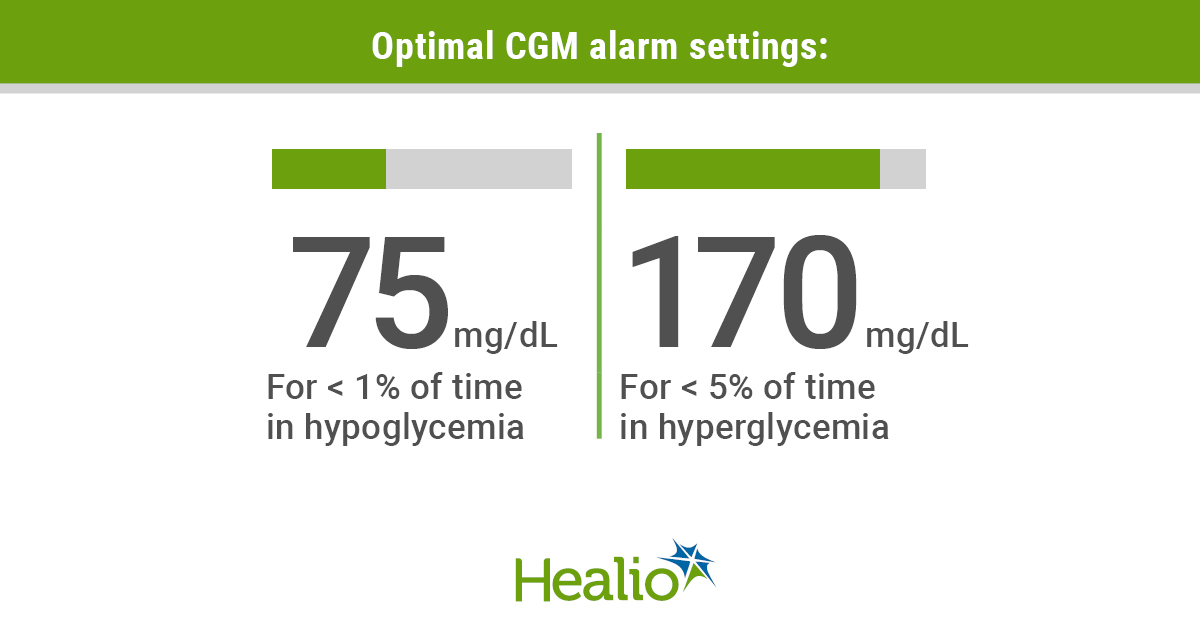CGM alarm settings may improve glucose outcomes in type 1 diabetes
Click Here to Manage Email Alerts
A cohort of adults with type 1 diabetes using continuous glucose monitor therapy spent about 50% less time in hypoglycemia and 65% less time in severe hypoglycemia when using a higher glucose threshold for hypoglycemia alarms, according to findings from an observational study published in the Journal of the Endocrine Society.

In the single-center study, the researchers also observed that individuals who set lower glucose thresholds for hyperglycemia alarms spent about 40% less time with glucose levels of 250 mg/dL or greater, without more time spent in hypoglycemia.
“The current study suggests that associations may exist between CGM alarm settings and glucose control in patients with type 1 diabetes,” Yu Kuei Lin, MD, assistant professor of internal medicine at the University of Michigan, told Endocrine Today. “Even though there are some drawbacks or adverse effects, CGM alarm-setting customization could possibly be considered as an ‘intervention’ for better glucose control in appropriate patients.”
In a cross-sectional, observational study, Lin and colleagues analyzed CGM alarm and glucose data collected at the University of Utah during a 2-week period for 95 participants with type 1 diabetes using CGM for at least 3 months. All participants were using a Dexcom CGM with a G4 (n = 7), G5 (n = 74) or G6 sensor (n = 14). The percentages of time spent in hypoglycemia and hyperglycemia were determined by the number of points below or above the hypoglycemia (70 mg/dL or 54 mg/dL) or hyperglycemia (180 mg/dL, 250 mg/dL and 320 mg/dL) glucose cutoffs over the total available glucose points. Researchers recorded CGM alarm settings, including the hypoglycemia and hyperglycemia alarm, repeat hyperglycemia and hypoglycemia alarm and glucose rise/fall alarm. For those who turned off the hypoglycemia alarm, a glucose level of 55 mg/dL, the factory setting of glucose threshold for an urgent low glucose alarm that could not be changed or turned off, was documented as the glucose threshold for hypoglycemia alarm. Researchers used logistic regression analyses to evaluate associations between CGM glucose profiles and the statuses of hypoglycemia and hyperglycemia alarms, repeat alarms and glucose fall/rise alarms.

Compared with participants who set a glucose threshold for hypoglycemia alarms at less than 73 mg/dL, participants with a glucose threshold for hypoglycemia alarms set at 73 mg/dL or higher spent lower percentages of time with glucose levels of less than 70 mg/dL (4.7% vs. 2.29%; P = .005) and less time with glucose levels of less than 54 mg/dL (1.5% vs. 0.53%; P = .016). The optimal alarm threshold to spend less than 1% of time in hypoglycemia was 75 mg/dL.
Among the 83 participants who turned on their hyperglycemia alarms, those with hyperglycemia alarm thresholds of 205 mg/dL or lower had lower average glucose levels when compared with those who had alarm thresholds of at least 205 mg/dL (mean, 155 mg/dL vs. 172 mg/dL; P = .02). Those with alarm thresholds of 205 mg/dL or lower also tended to have lower percentages of time with glucose levels of at least 180 mg/dL (30% vs. 37%; P = .099) and spent less time with glucose levels greater than 250 mg/dL (8.36% vs. 14.5%; P = .016) and greater than 320 mg/dL (2.02% vs. 5.13%; P = .007). The optimal alarm threshold for spending less than 5% of time in hyperglycemia and an HbA1c of 7% or less was 170 mg/dL.
The researchers noted that the cross-sectional nature of the study does not allow assessment of actual responses and tolerance of CGM setting changes and that the results were based only on Dexcom CGMs. Additionally, variability observed across the current cohort reinforces the need for future studies that take into account individuals’ behavioral and physiological characteristics to further the goal of a more personalized approach of configuring alarm settings, the researchers wrote.
“Further interventional studies are needed to prove the current concept and to identify those who will or will not respond to CGM alarm setting customization,” Lin said. – by Regina Schaffer
For more information:
Yu Kuei Lin, MD, can be reached at the Division of Metabolism, Endocrinology and Diabetes, Department of Internal Medicine, University of Michigan Medical School, 24 Frank Lloyd Wright Drive, Lobby C, Suite 1300, Ann Arbor, MI 48106; email: yuklin@medn.umich.edu.
Disclosures: The authors report no relevant financial disclosures.
